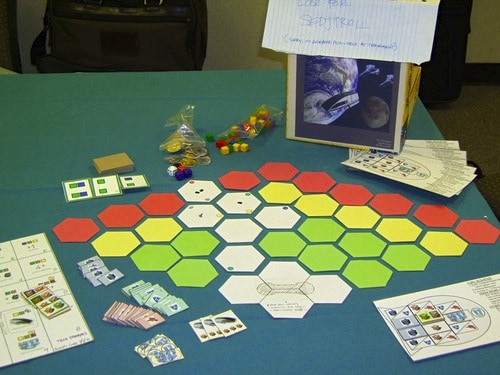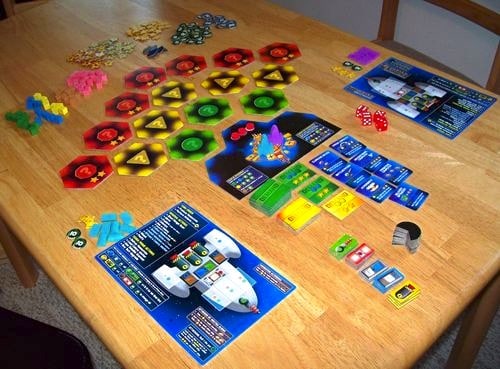
(This is the first post on the League by designer Seth Jaffee. For those who are new to “sedjtroll,” Seth is a self-described “Structural Engineer, Board Game Designer, Ultimate Frisbee Player, and Strategy Gamer.” Seth has his hands in all aspects of the game industry – with designer credits on Eminent Domain and Terra Prime, as well as developer credits on many Tasty Minstrel Games titles such as Belfort, Ground Floor, Kings of Air and Steam, and the new Captains of Industry. He’s also very active on BoardGameGeek, Twitter, and runs The Board Game Designers Forum. He also has his own design blog: “Cumbersome,” where he discusses the successes and challenges of his current design work. You’ll find Seth at just about every game convention exploring new games and running demos for TMG.)
—
BAD PLAYS AND RUINED EXPERIENCES
Sometimes, while playing a game, you find yourself in a very bad spot. Perhaps you find yourself bankrupt, dead, or otherwise out of the game altogether. Or worse, you’re NOT out of the game, but you cannot make any progress! You sit there helpless watching your friends having a great time. Often the only way to get stuck in that bind is by making a bad play – a mistake, an ill-advised move, or possibly a calculated risk that doesn’t pan out. Even if it’s rare, whenever this happens, it usually means a miserable experience for the player.
As a designer there’s a temptation to accept this dynamic in your own game, and to defend your design choice by saying “yeah, that would suck… don’t do that.” And to some extent maybe that’s ok… The question is, what’s that extent?
IS IT THE DESIGNER’S RESPONSIBILITY TO ENSURE BAD PLAY DOESN’T RUIN A PLAYER’S ENJOYMENT OF A GAME?
Every designer will have their own answer to this question. There are very good games, which do not protect players from making game-ending mistakes. Perhaps the designers of such games do not notice the issue because it doesn’t come up in their playtests, or maybe they’re aware of the issue and rely on players to avoid the bad plays that can lead to that dire situation. No answer is really wrong, it can be acceptable to allow bad plays to lead to poor game experiences.
TAKING RESPONSIBILITY
I personally want every player to have the best chance of enjoying my games, so I take that responsibility upon myself. That wasn’t always the case – I used to respond to a “poor play” problem in my game with phrases like, “Well, play better and you won’t have that problem.” But over time I’ve realized that, with such a wide range of players, these poor play situations will come up more often than I might have expected at first. And frankly the thought of any player having a bad experience – even if it’s their own fault – is unacceptable to me. This is especially true when the player is put into that situation not because of a mistake or bad play, but because they made a reasonable play or calculated risk, and something unforeseen occurred which left the player in such a bad position.
A PERSONAL EXAMPLE: TERRA PRIME
I suppose I’ve been fairly vague about what I mean. What are these “poor play” problems, and what dire situations might players find themselves in? By way of example, here’s a story about my first published title, Terra Prime. In Terra Prime there are green, yellow, and red space hexes which you can explore looking for planets to colonize. The green hexes are safe – when you explore them you will never find any hostile aliens looking to blow you out of the sky. The yellow hexes are more risky, there are some hostile alien scouts, and even a few warships. The red hexes are very dangerous, with even more, and stronger, alien threats.
The intent is for players to begin exploring green space, and only venture into yellow space after preparing with shields, or scanning the tiles to find out if they’re safe. The game attempts to forecast this information, not just with the color coded hex tiles, but with the existence of shields, the rules regarding hostile alien attacks, and the fact that there’s a scanner one can use to peek at the tiles. Originally I thought that should suffice, and if a player bull-headedly ventured into yellow space unprepared, they run the risk of being blown to pieces. Since players shouldn’t do this, it shouldn’t be a problem – right?
During a play test session of an early version of Terra Prime, when warned about the dangers of yellow space during the rules explanation, one player I know intentionally ignored the warnings and ventured out sans shields. Of course he found the most dangerous aliens possible, and as you might expect, they did their worst.

In Terra Prime your ship has modules – cargo modules carry resources, engine modules give you actions, weapon modules let you attack aliens, and shield modules protect you from attacks. When you are hit by aliens, you lose modules until you have no more to lose, then you start losing points. In that version of the game, only 1 engine was “built in,” so when the player had the rest of his engines blown off of his ship, he had to limp back to base to repair, and had to do so with only 1 action per turn rather than the normal 3. This took several turns of that player doing basically nothing before he could rejoin the game, and even when he got to play at full capacity again, he was mathematically eliminated from winning.
This was a perfect example of a poor play that led to a miserable game experience. As much as I wanted to believe that players wouldn’t be so foolish, or that players who were that foolish deserve the miserable experience, the fact of the matter is that that those players would not want to play again. I’d much rather have players enjoy my games even if they get themselves stuck in a bad position, so I made an adjustment: in the final version of Terra Prime, your ship has 3 built in engines, which means no matter what you will always have at least 3 actions a turn. It’s still ill-advised to venture into yellow space, but if you do, you will at least still be able to play the game.

WHAT ARE YOUR THOUGHTS?
I’d like to know what others think about this. What is the responsibility of a designer to prevent bad play from ruining a player’s game experience? What steps have you taken in your designs to safeguard against it? Please share your thoughts in the comments section below!








